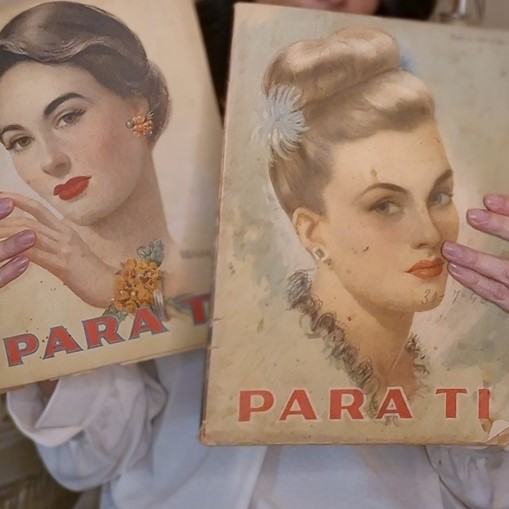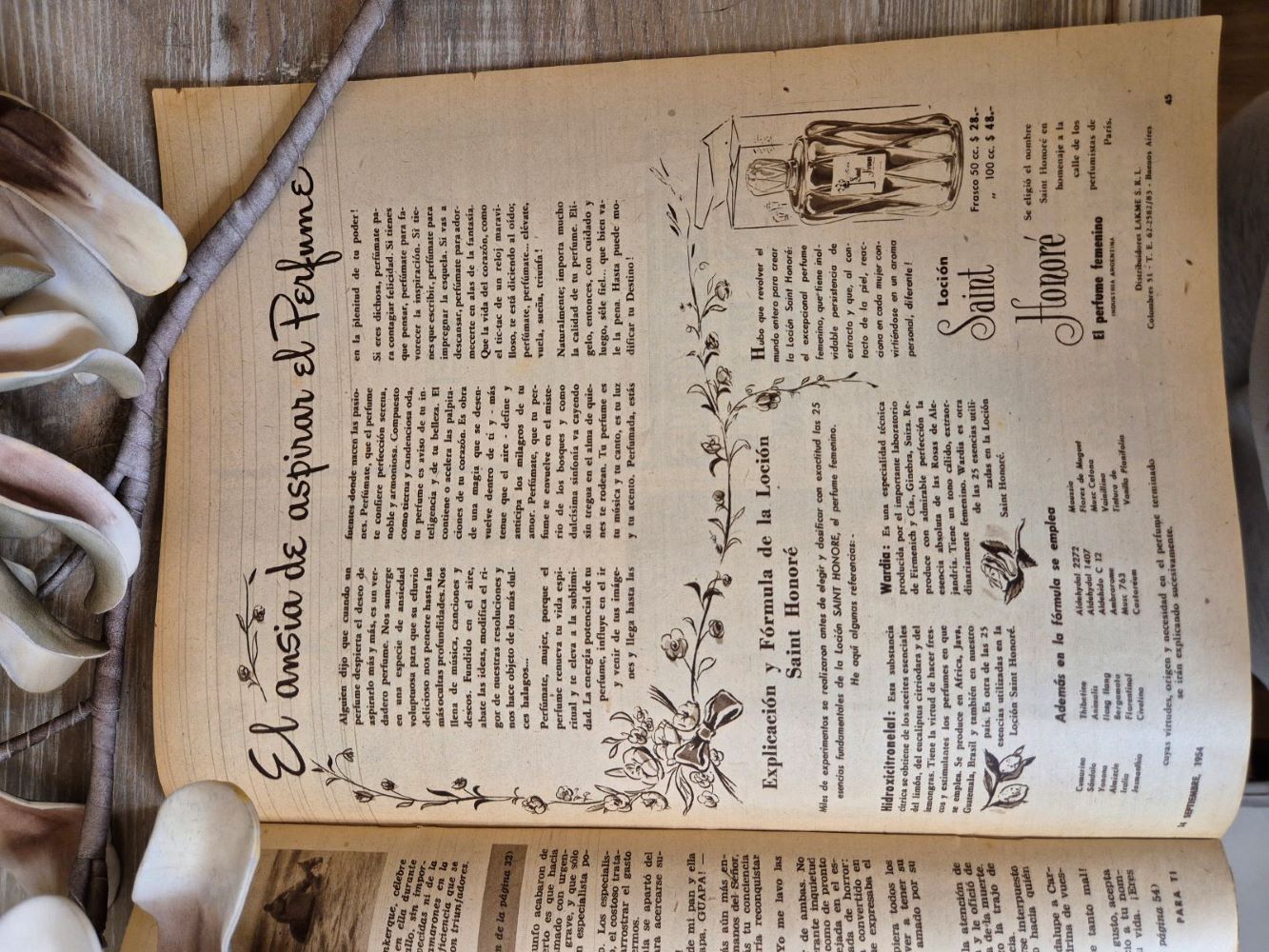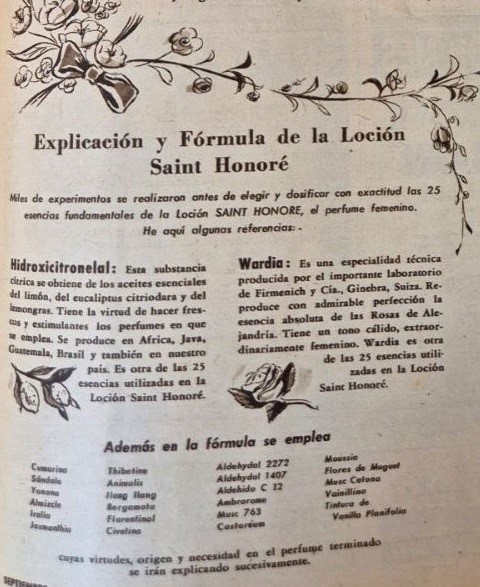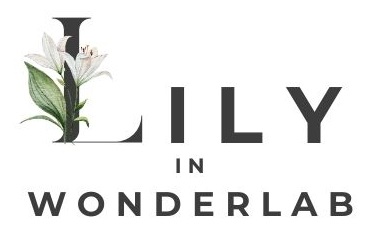In my small collection of vintage feminine magazines, I often find myself getting lost in their elegant illustrations (like the ones by Raúl Manteola), the delicate beauty advertisements and the lovely crafted words. I love imagining the world they belonged to, pausing especially on the beauty pages, where time seems to stand still in a cloud of rice powder, violet perfumes and elegance.
In a 1954 issue of the Argentinian Para Ti magazine, I discovered a hidden treasure: an article titled “El ansia de aspirar el perfume”—The Scent We Yearn to Inhale. I knew instantly I had to share it with you. It speaks so deeply to the Lily in Wonderlab way of seeing beauty not as something superficial, but as a holistic, sensory experience that touches the soul.
Perfume is not just an object, it’s a feeling. It awakens something inside: joy, longing, tenderness. It’s that invisible force that shifts your mood, lifts your spirit and transports you somewhere else, in a magical word, in a different state of mind. A need, a craving, a dream in the form of scent. A secret language without words, powerful enough to leave its trace on your soul.
And when you find the one, the fragrance that feels like it was made just for you… it becomes a treasure. A part of you. Something you hold close and never let go.
So, come with me and continue reading. Let’s step into the pages of this 1954 unique wonder and explore the beauty rituals, curiosities and scented stories of another time…
The Scent We Yearn to Inhale (Translation from Para Ti, 1954)
But first, let’s read it together. In the photo, you can see the full page just as it appeared in Para Ti, framed with delicate lines, softly aged and full of charm. It’s a piece that feels more like a whispered poem than a magazine article.

If you can’t read Spanish, don’t worry, I’m posting the translation for you here, so you can feel every word, every breath of its scented world…
Someone once said that when a perfume awakens the desire to breathe it in more and more, it is a true perfume. We could call it a sort of anxious longing, sweet and delightful, aroused by its fragrant trail.
That delicate presence that surrounds us—filled with music, songs, lights and shadows, modified by reflections of tender memories or noble desires—calls out to the sensitivity of women.
Perfume—mystical, because it elevates and ennobles the soul; real, because it soothes nerves and awakens affection; noble, because it brings out our finest emotions; and sensual, because it brings the skin to life and touches the heart.
Perfume, that noble art of essence, was created to awaken joy. Composed of both intimate and radiant notes, it plays upon sensitivity and beauty. A perfect perfume is one that glides gently over the skin and lovingly embraces the senses.
What does a woman seek in her perfume? She wants it to reflect her mood and her dreams. Perfume, the invisible garment, must speak of her without a word.
That’s the mystery, the subtle communication of a fragrance that can say what lips don’t. Perfume transmits tenderness, or boldness, or serenity—depending on the moment, the heart, the soul.
Let it be part of your essence. Let it accompany your presence. That’s how you reach the fullness of its power!
If chosen well, perfume can bring happiness. If it's not right, it can stifle. But if it suits you perfectly, it becomes unforgettable. If you recognize yourself in it, never let it go.
What the voice says softly, the fragrance can shout. That’s why from olden times, perfume has been called the voice of the soul.
When Scent Speaks to the Soul
Reading the original text, I loved how tenderly perfume is described, not as a mere object, but as an experience, almost a living presence. It’s rare to find a writing that captures scent in such a emotional way. “Perfume… mystical, because it elevates the soul; real, because it soothes the nerves; sensual, because it touches the heart.” There’s something beautifully intimate in that. The text doesn’t speak to vanity or trends, but to inner sensation, to the invisible thread between scent and soul.
This vision of perfume and beauty in general feels so close to my own, to what I try to express through Lily in Wonderlab. Here, beauty isn’t something superficial. It’s not about perfection, it’s about sensation, connection and joy.
Fragrance is a form of quiet self-expression, a secret language. That’s how I experience scent too, not as an accessory, but as something that becomes part of who we are. Something soft and personal, powerful enough to influence the way we move through the world. It’s this invisible poetry that makes beauty meaningful to me, and why this forgotten page from 1954 felt like it had been waiting for me all along.
The Gift Before the Perfume
What immediately captured my attention, beyond the graceful language, was the way the article subtly shifted from poetic reflection into subtle advertising. It sparked my curiosity, as it was so gently done.
Instead of leading with the product, they first offered something else, something valuable: a moment, a mood, a beautifully written thought.
They gave the reader a gift before they ever spoke of the perfume. A piece of writing that was genuinely pleasurable to read: lovely, passionate and true. It wasn’t an advertising, it was a sincere ode to perfume as emotion, memory and mood. The kind of paragraph you might read twice just to feel it again. Just like the perfume you crave for.
Only after that soft immersion they introduce Saint Honoré perfume not as a commercial interruption, but as the natural evolution of what the article had just made you feel.
It’s a strategy I’ve seen again and again in vintage magazines. The best of them knew how to create a bridge between storytelling and product by giving first. They offered something meaningful, something emotionally or intellectually satisfying before ever asking for the reader’s attention. A graceful way to connect.
The Language of Ingredients
After that beautiful reflection on perfume, the article gracefully transitions into the formula itself. It doesn’t feel weird. On the contrary, it’s as if they wanted to guide the reader from feeling into understanding. They reveal the composition of Saint Honoré Perfume in full detail: around 25 ingredients, carefully listed,like a sort of primordial INCI.
They weren’t only selling a dream, they were opening it up, piece by piece, as if saying: “Here’s what it’s made of. Here’s why it matters.” In most modern marketing, fragrance descriptions are vague, often poetic but empty: “a breeze of wild flowers” , “a spark of mystery”... poetic words that rarely inform. But here, in 1954, the tone is almost educational. They wanted the customer to understand the product. They valued the intelligence and curiosity of the reader.
The formula itself is a mix of natural and synthetic ingredients. We find beloved naturals like ylang-ylang, bergamot and sandalwood, but what caught my attention is the strong presence of synthetic aromatic molecules like hydroxycitronellal and more. These weren’t hidden or softened. On the contrary, their inclusion was presented with pride, a sign of innovation, modernity and sophistication.
This is something I’ve observed many times in my own collection of antique cosmetic formulary books from the 1930s and 40s. At that time, the introduction of synthetic aromatics was seen as revolutionary. Not as a replacement for nature, but as a bold new tool for the formulator. They allowed for longer-lasting and, especially, cheaper scents. In the ancient beauty world, synthetics were often celebrated as the future. And in this case, Saint Honoré follows that trend, emphasizing the complexity and modernity of its blend.
Today, things changed. In the clean beauty and natural cosmetics world, we now place more value on formulations made entirely of natural raw materials: essential oils, absolutes and sometimes even whole botanicals (click here to read the article I wrote about it, learning how to naturally scent your DIY cosmetics).
Luckily, we’ve moved from celebrating synthetics as modern to questioning them, seeking a return to nature.
Some of the molecules listed in this 1954 formula can still be found in natural-certified cosmetics when derived directly from essential oils and handled within strict eco-certification standards. But today’s natural formulations tend to focus more on whole, pure ingredients, not isolates.
One of those molecules caught my eye especially: ionona, or ionone, the delicate compound behind the scent of violets. It appears again and again in my vintage books, a constant in the history of perfumery. Violets themselves are famously poor in extraction, but ionones made it possible to replicate their softness, that powdery, dreamy note that always feels like a whisper from another time. Ionones are synthetic aroma compounds first isolated from orris root and found naturally in some essential oils.
Along with other aromatic compounds, they can be used in natural-certified cosmetics (such as those under COSMOS or ECOCERT standards) if derived from natural sources.
Also, they emphasized with pride the fact that the perfume contained many ingredients sourced from different parts of the world, transforming the formula into a scented voyage, where each note added a sense of rarity and refined value.
I love observing how our relationship with ingredients, with scent, with what we consider “luxury” or “modern,” continues to evolve. This magazine page is more than an advertisement or a nice reading, it’s a window into what mattered then. And reading it today, we can trace how far we’ve come.
What moves me most about this page is the idea that beauty isn’t just something we see, but something we feel. Something that stirs the senses, changes the day, touches a quiet part of us.
It’s what I try to preserve here in my wonderlab. To remind us that the ritual of beauty can be soulful and sacred. That a scent isn’t just a smell, it’s a mood, a mirror, a bit of memory caught in the air.
So here, from the fragile pages of a 1954 Para Ti, I bring you not just an old article, but a moment. A scented story. A reminder that even then, beauty was a world to enter, not just a product to buy.
And I’ll keep sharing more—more vintage pages, more perfume curiosities, more formulas. Let me know on Instagram what you'd love to explore next and feel free to share your thought with me!

